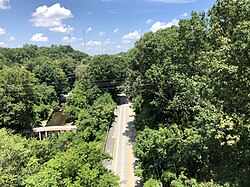Jones Falls Trail

Jones Falls Trail (typically abbreviated JFT) is a hiking and bicycling trail in Baltimore, Maryland. It mostly runs along the length of the namesake Jones Falls, a major north–south stream in and north of the city that has long acted as a major transportation corridor for the city. It also incorporates the bike path encircling Druid Hill Reservoir and its namesake park. The Jones Falls Trail forms a segment of the East Coast Greenway, a partially completed network of off-road bicycling routes that runs the length of the East Coast.It is projected to extend from the Baltimore waterfront at the Inner Harbor north to the Mount Washington neighborhood, passing through Cylburn Arboretum and Mount Washington Arboretum. The Baltimore City Department of Recreation and Parks owns, manages, and maintains the trail.
Excerpt from the Wikipedia article Jones Falls Trail (License: CC BY-SA 3.0, Authors, Images).Jones Falls Trail
Lake Drive, Baltimore
Geographical coordinates (GPS) Address Nearby Places Show on map
Geographical coordinates (GPS)
| Latitude | Longitude |
|---|---|
| N 39.31748 ° | E -76.631572 ° |
Address
Lake Drive
Lake Drive
21211 Baltimore
Maryland, United States
Open on Google Maps









